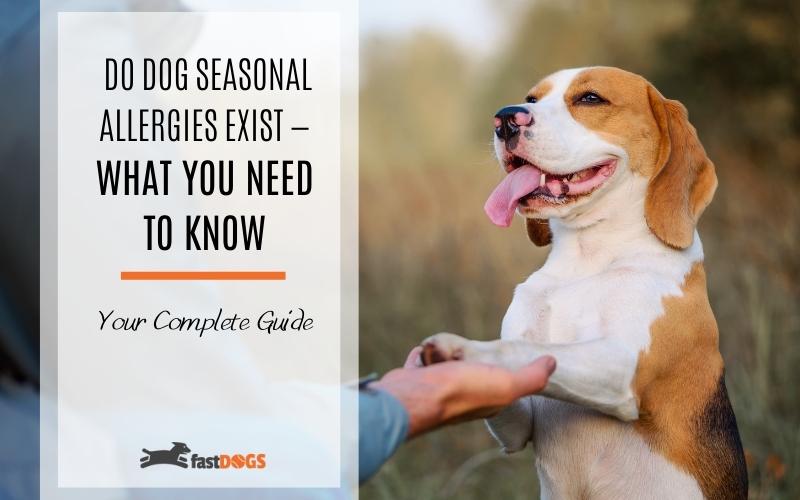Do Dog Seasonal Allergies Exist — What You Need To Know

Dog Seasonal Allergies
Do you find at a certain point during the year, your pooch seems to appear under the weather, with no real cause behind it? Have you considered dog seasonal allergies?
You may wish to give it some thought.
Seasonal allergies in dogs are far more common than you might realize, and certain breeds are more susceptible. Hence, to help you either decide or rule out the time of year environmental offenders, we’ve put together this seasonal dog allergies 101.
Signs of Seasonal Allergies in Dogs
If you’re wondering, what are the symptoms of a seasonal allergy in dogs? Here’s a list of the common signs:
Scratching/Itching
With itching being one of the most common symptoms of seasonal allergies, as well as food allergies, you shouldn’t base your decision on this factor alone. Fleas, mites, and skin conditions like dermatitis, all cause pruritus (incessant itching).
Your tail-wagger may scratch more frequently when outdoors and in close contact with pollen and allergens, or shortly after coming inside. While it can be mild, sometimes dogs can seem very distressed and in discomfort from exposure to the outside world.
Over-Grooming
Linked to itching — your bow-wow may be less inclined to viciously scratch more sensitive spots of their body, such as paws, private parts, and belly. Instead, they may lick these areas in an attempt to soothe them. Over-grooming can lead to sensitive skin, which can exacerbate discomfort — particularly if their skin is already sore and inflamed.
Hair Loss
If your dog has seasonal allergies, this won’t be the first symptom you notice. Hair loss is a knock-on effect of over-grooming and itching.
Over time, the persistent scratching and nibbling to ease the irritation causes redness and damage to their hair follicles. In short, this means their fur will fall out from the trauma and lead to more discomfort with this new level of skin visible.
In a worst-case scenario — if you don’t treat your pooch fast enough it could cause permanent damage and the fur won’t grow back in the areas affected.
Ear problems
Scratching at their ears is a normal dog behavior, but if performed excessively can lead to inflammation and infection. You may first notice them excessively shaking their heads or scratching, maybe even a sensitivity to touch when you pet them.
Other signs will be redness within the ear due to swelling and possibly a strong, foul smell which indicates infection. Ear infections are common in many breeds of dogs, and your vet will be able to prescribe some drops to help clear it up and treat their allergies.
Eczema/Dermatitis
Direct contact with their allergy trigger can cause patches of eczema, dry skin, and dermatitis. This type of complaint is very common, so you need to be sure it's as a result of dogs with seasonal allergies. It can also worsen with time during the season they are most affected.
Your pup may also have greasy skin with a yeasty smell that they cannot stop licking, rubbing, and scratching away at. You will be able to spot dermatitis in places such as their:
Feet.
Belly.
Groin.
Armpits.
Muzzle.
Face/around the eyes.
Sneezing
Of course, a certain level of sneezing is totally normal in your furry friend, especially as they explore the world through their noses. But, if on returning from walkies or time in the backyard you notice a sneezing frenzy — especially at a certain time of year — this may be another key sign of dog spring allergies, or fall allergies in dogs.
Reverse sneezing is also normal in this situation, and although it can seem very alarming the first time they do it, it’s nothing to worry about if they do so occasionally. Repetitive reverse sneezing can be a sign of seasonal allergy in dogs. However, it can mean other complaints such as an infection, masses, and nasal mites.
Bear in mind, if your dog has these symptoms at other periods during the year, you may want to consider there may be another issue at hand.

Types and Causes Of Seasonal Allergy In Dogs
If you suspect your dog has seasonal allergies, what could the potential allergen be?
Atopic Allergies — Research suggests the most common allergy trigger is the household dust mite — contributing to dog fall allergies. The second is Japanese Cedar pollen and molds, normally found in the spring.
Plants — According to this study, more allergic reactions were seen during the summer and fall, with reactions to mold, plants, and trees being the most prevalent. These allergens led to skin, ear, and yeast infections.
Non-Hereditary Allergies — Although there are breeds prone to developing allergies due to their genetics, this only comprises a small number of dogs that develop seasonal allergies. The increase without any prior genetic susceptibility is concerning. Factors such as CO2 emissions, exposure to plastics, and other environmental issues are to blame.
Pollen — Weed, tree pollen, and grass pollen are the main reason behind seasonal allergy symptoms in dogs.
By finding out what type of pollen triggers your dog’s seasonal allergies, you can help limit exposure and ease their symptoms. Here are a few tips:
Weed pollen is found mostly in areas with overgrown plants and with a large abundance of grasslands. You may want to opt to walk your pooch in areas that don’t have this type of terrain — eliminating the amount of weed pollen they come into contact with. Also, maintain any garden areas they use at your home to make sure this kind of pollen doesn’t blow into your home with the breeze.
Tree pollen is a tricky one to keep away from, but avoiding lengthy walkies on windy days is a good place to start — the breeze spreads pollen far and wide. And, if you know pollen counts are due to be high, keep any windows and doors closed.
Grass pollen exposure can be reduced by not letting them roll around on the grass. This seemingly harmless act allows the pollen to work into their skin, and it’s tough to remove all traces. If possible, during high pollen seasons, take your tail-wagger to the beach instead of a park.
How to Treat Seasonal Allergies in Dogs
Now you’ve read up on the signs and symptoms, you’ll want to know what dog seasonal allergies treatment will help ease the condition.
The first step is to figure out the trigger of their allergy. For example, maybe a certain flower or heavily grassed area sets off your pooch. The best treatment is to avoid the allergen to prevent — or minimize — symptoms from manifesting in the first place.
Your vet will also be able to help you pinpoint the cause through testing.
However, they may recommend other options before coming to this decision to rule out any other conditions with the same symptoms as dogs with seasonal allergies.
And, while you can’t eradicate the condition in its entirety, you can provide seasonal allergy relief for dogs. Here are a handful of ways you can help to treat your poorly pooch by making small changes to their daily life.
Medicated shampoos — If itching is causing them to scratch like there’s no tomorrow, this could be a doggy lifesaver! Having a bath can prevent dry itchy skin and eliminate any allergens that may be trapped in their fur. Creams are also available — these are ideal if only a certain area is affected.
Reassess walkies — While you and your tail-wagger may love your exercise regime, during peak pollen season you may have to rethink your route. This may be trial and error, to begin with, but try to avoid areas with tall grass, plants, or trees in blossom. It may be a case of sticking to paved areas. Another key treatment would be to ensure that their feet, belly, and paws are wiped down after every walk.
Clean home environment — Your dog will still be at the mercy of seasonal allergies inside the home. To help them out, ensure that you vacuum at least once a day. You could also invest in an air purifier, which can trap, thus reducing many circulating airborne allergens.
Supplements via your dog’s diet — Offering your bow-wow Omega-3 and 6 fatty acids can potentially relieve seasonal skin allergies in dogs. This will help to improve the general health of your dog’s skin.
Medicated ear drops — A great way to prevent an infection in your puppy's ears before requiring more aggressive treatment. The drops will help to clear out any gunk that may be lingering.
Antihistamines — In some cases, human antihistamines such as Diphenhydramine (Benadryl) can be taken by your dog. However, you should consult your vet before administering. The dosage level must be precise, if not, it can be fatal. If you’re finding home remedies aren’t alleviating your pooches ailments, have a chat with your vet, they will be able to prescribe alternative conventional canine treatments.

Conclusion
If you’re now convinced and thinking “my dog has seasonal allergies,” hopefully our tips and information have provided you with everything you need to keep your furry friend comfortable.
Remember, while dog seasonal allergies can’t be cured, there are steps you can take to help your pooch through the spring, summer or fall.Dog Seasonal Allergies FAQs
What Months Are Allergy Season for Dogs?
Dogs can develop allergy symptoms at any time of the year but if your pet is suffering from allergies to pollen, then spring, summer, and fall are the main seasons.
How Can I Treat My Dog's Allergies?
There are a number of ways that you can treat your dog's allergies from medications such as
Antihistamines.
Decongestants.
Allergy shots.
There are also some natural remedies, and you could consider lifestyle changes to reduce allergens.
Can Dogs Get Hayfever?
Yes, dogs can get hayfever, and there are some common symptoms for you to look out for:
Sneezing.
Coughing.
Excessive scratching.
What Time of Year Do Dog Seasonal Allergies Occur?
Like us, dogs can suffer from seasonal allergies at any time of the year. During the spring, summer, and fall is when pollen allergies can cause pets the most discomfort.
Can Dogs get Seasonal Allergies?
Dogs can get seasonal allergies in the same way as humans do. Signs that your dog may have a seasonal allergy are:
Sneezing.
Red, itchy eyes.
Congestion.
Scratching.
Are Certain Breeds More Susceptible to Allergies?
Believe it or not, there are certain dog breeds that are more prone to developing seasonal allergies than others. Breeds such as Golden Retrievers, Boxers, Shih Tzus, and Labrador Retrievers.
What Can I Give My Dog for Seasonal Allergies?
You can safely give your dog Benadryl if they are suffering from a mild to moderate reaction to allergies. It can be used to treat allergies such as seasonal, food, environmental, and even insect bites.
